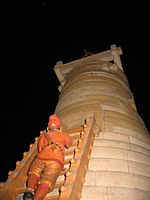- Cheomseongdae
-
Coordinates: 35°50′11″N 129°13′18.4″E / 35.83639°N 129.221778°E
Cheomseongdae 
Korean name Hangul 첨성대 Hanja 瞻星臺 Revised Romanization Cheomseongdae McCune–Reischauer Ch'ŏmsŏngdae Cheomseongdae is an astronomical observatory in Gyeongju, South Korea. Cheomseongdae means star-gazing tower in Korean. Cheomseongdae is the oldest surviving observatory in East Asia, and one of the oldest scientific installations on Earth. It dates to the 7th century to the time of kingdom of Silla, which had its capital in Gyeongju. Cheomseongdae was designated as the country's 31st national treasure on December 20, 1962.[1]
Contents
Overview
According to Samguk Yusa, Cheomseongdae was constructed under the reign of Queen Seondeok (632-647) near the capital of the kingdom. Cheomseongdae means "star gazing platform". The tower is built out of 362 pieces of cut granite which some claim represent the 362 days of the lunar year. Some surveys of the site have indicated that there are 366 blocks.[2] It has 27 circular layers of stones (some associate it with the fact that Queen Seondeok was considered to be the 27th ruler of Silla or the constellation of stars) surmounted by a square structure. 12 of the layers are below the window level and 12 are above. There are 12 large base stones set in a square, with three stones on each side. These sets of 12 may symbolize the months of the year.
The tower is 5.7 meters wide at the base and 9.4 meters tall, and filled with earth up to the level of the window. Its construction style parallels that used at the Bunhwangsa Temple in Gyeongju.
The Cheomseongdae is the oldest surviving observatory in East Asia, though some claim that Cheomseongdae was not suitable for astronomical observation. Others posit that it was used for astrology rather than astronomy, though during that era there was little differentiation between the two. Some scholars have argued that the Cheomsongdae's design was heavily influenced by Buddhism, noting similarities between its design and Mount Sumeru, the center of the world according to Buddhist mythology.
Notes
References
- Jeon, Sang-woon. (1998). A history of science in Korea. Seoul:Jimoondang. ISBN 89-88095-11-1
- !Nha, Il-seong. Silla's Cheomseongdae. (2001) Korea Journal 41(4), 269-281 (2001)
- E-Korea Journal: Song, Sang-Yong. A brief history of the study of the Ch'ŏmsŏng-dae in Kyongju; Korea Journal 23(8), 16-21 (1983)
External links
Categories:- National Treasures of South Korea
- Astronomical observatories in South Korea
- Science and technology in Korea
- Silla
- Gyeongsangbuk-do
- Korean astronomy
- 7th-century architecture
Wikimedia Foundation. 2010.

